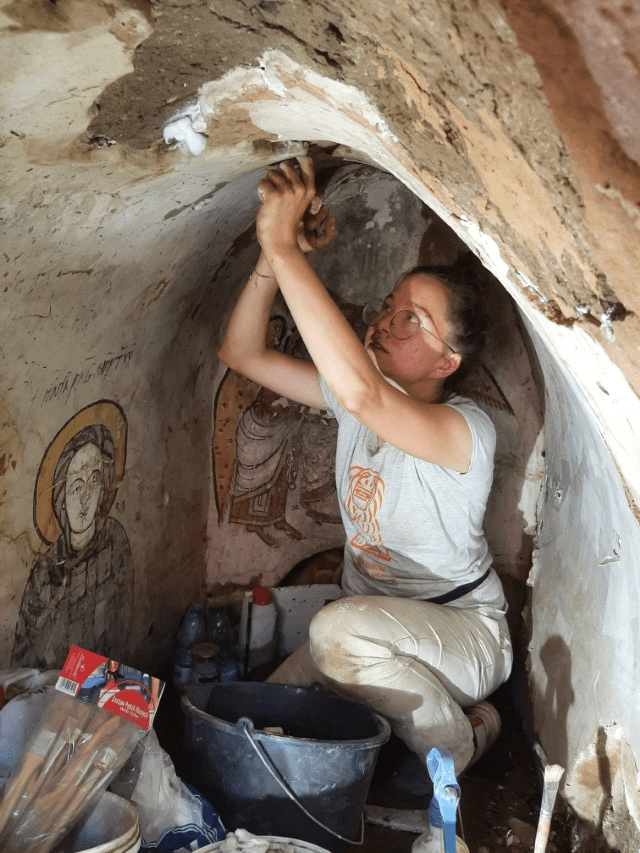An accidental discovery in the ancient town of Old Dongola, Sudan, has revealed a set of medieval Christian paintings unlike any seen before.
Old Dongola, in the North of Sudan, may not look like much to the untrained eye. Nestled in the eastern Sahara Desert, it’s been completely deserted since the 19th century, when its entire population moved 160 kilometers (100 miles) away and across the Nile, leaving only the ancient ruins that now dot the landscape.
But to the archaeologists that have been excavating the town since the 1960s, Old Dongola is a seemingly bottomless treasure trove. It was only last month that the Polish team working on the site uncovered the remains of a temple dating back close to 3,000 years; before that, it was the discovery of a vast medieval cathedral that was making the headlines.
Now, it’s a mysterious complex of ornately decorated chambers that are rewriting our understanding of the history of the region. Discovered entirely by accident under the floors of a more recent building, the relatively small rooms are built from sun-dried brick and covered with vaults and domes; one in particular resembles a crypt, despite being located much higher than would be expected in that case.
But it’s the walls that are the most striking aspect of the new discovery: each are covered with what experts have described as “unique representations” of Christian art.
In one painting, the virgin Mary is shown in dark robes holding a cross and a book; facing her is an image of Jesus holding a book in one hand while the other offers a blessing to the audience. In another scene, a local Nubian king bows to Jesus and kisses his hand as the Archangel Michael shields the pair with his wings – imagery which the team behind the discovery noted in a statement “finds no parallels in Nubian painting.”

The image of the virgin Mary. Image credit: Magdalena Skarżyńska, University of Warsaw
Accompanying the paintings are something just as tantalizing: a series of inscriptions that offer hints as to the history and motivation behind the artworks. While some, written in Greek, are not unexpected for a religious setting – archaeologists have identified them as excerpts from the Liturgy of the Presanctified Gifts, an Eastern Christian service performed during the weekdays of Great Lent – others are recorded in Old Nubian, and it’s here that things get really intriguing.
These latter inscriptions are much harder to decipher, but what little the team have been able to make out includes several mentions of a King David, as well as a plea to God for protection of the city – most likely Dongola itself.
If so, it could be a reference to what we now know would be Dongola’s downfall. “David was one of the last rulers of Christian Makuria, and his reign marked the beginning of the end of the kingdom,” the experts explained in the statement from the University of Warsaw. “For reasons unknown, King David attacked Egypt, which retaliated by invading Nubia and, as a result, Dongola was sacked for the first time in its history.”
Perhaps, they suggest, the artworks were created as the city prepared for an oncoming – or maybe even ongoing – siege at the hands of the Mamluk Egyptian forces in 1276. With further research, the team hopes that this mystery, as well as others – like why it was that King David launched his attack against Egypt in the first place – may at long last fall into place.

Preservation work on the discovery. Image credit: Dawid Szymański, University of Warsaw
Until then, however, the priority for both the researchers and the discovery itself is preservation. To that end, a conservation team has already been hard at work on the site, securing the frescos with protective bands and putties and filling empty spaces between the wall and the plaster with injection fluid until excavations can continue.
“Work in such a confined space, under pressure of time and in high temperatures typical for March in Sudan was extremely demanding,” the team report. “The paintings were detached from the walls in some places, but the painted layer itself was remarkably well preserved.”
“Further excavations may provide answers to [our] questions about the enigmatic structure,” they conclude. “We may find out whether or not the uncovered structure is a royal commemorative complex, when archaeologists… return to Dongola in autumn.”
Source Link: "Unique" Medieval Christian Art Discovered By Accident In Sudan Desert